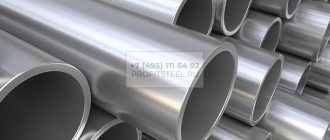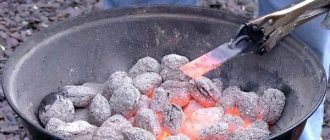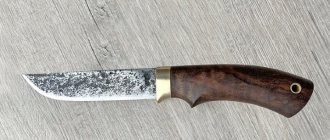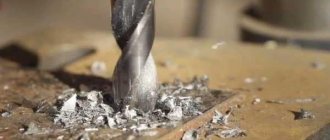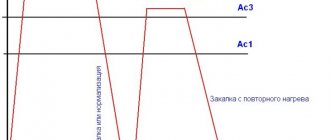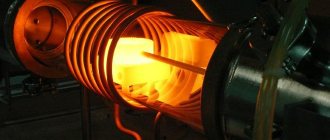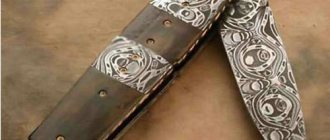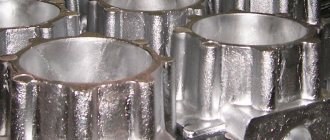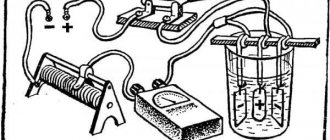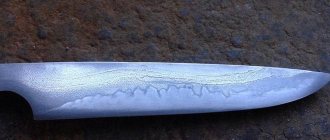Steel tempering is a type of heat treatment used for products that have undergone hardening with a polymorphic transformation. What does "tempered steel" mean? This is steel heated below temperatures at which a change in the type of crystal lattice occurs. Next, the metal is kept heated for a certain time, followed by slow cooling, usually in air. The purpose of tempering is to weaken or eliminate internal stresses, increase ductility and toughness, slightly reduce the hardness obtained during hardening, and reduce brittleness. The quality of the hardened part largely depends on the correct execution of heat treatment. Depending on the intended purpose, the optimal process mode is selected.
Types of vacation
This type of heat treatment is characterized by: low heating of the part to 150-250°C, holding at these temperatures and cooling in air. When the supply is low, the following processes occur:
- a “tempered martensite” structure is formed (a product of the decomposition of martensite formed at a temperature below the austenitic-ferritic transformation);
- internal stresses are partially eliminated;
- viscosity increases without a noticeable decrease in hardness.
This tempering is most often carried out for tool steels.
Tempering at low temperatures is called “aging”. Types of “aging”:
- Artificial. The parts are heated to 120-150°C and maintained at these temperatures for 18-35 hours. The process takes place in baths with automatic temperature control.
- Natural. It is carried out at room temperature, tools and products are kept in such conditions for three months or more.
“Aging” of hardened parts and tools serves to stabilize dimensions while maintaining a sufficiently high hardness.
Average tempering temperatures range from 300-500°C. In this case, a fairly significant decrease in hardness and an increase in viscosity occurs. This heat treatment is used for tools that must have significant toughness, strength and elasticity, as well as for springs and leaf springs.
Performed at temperatures of 500-650°C, it leads to the formation of a structure that provides the product with an optimal combination of strength and ductility. Used for parts made of structural steels 35.45, 40X and intended for operation under shock loads.
Definition! The operation of hardening followed by high tempering is called “improvement”.
How to temper hardened steel correctly?
This operation must be performed immediately after hardening, since the part may become cracked due to the presence of high residual stresses. If the tempering regime is violated - insufficient heating or short holding time - “under-tempering” occurs, in which the part remains brittle. To eliminate this drawback, repeated tempering is used.
Approximate hardness of steel (Rockwell) after heat treatment in various modes, including quenching and tempering
Source: metallz.ru
Hardening and tempering of metal at home - technology and tables
In a simplified form, the process of hardening a metal consists of increasing the temperature of the sample to high values, and then cooling it. But it's not that simple. And this is explained by the fact that different types of metals differ in their structure and, accordingly, specific properties. Therefore, certain techniques (and temperatures) are used to harden them. We will talk about them, as well as the specifics of carrying out the relevant operations.
First of all, it is worth noting that heat treatment (hardening) of metal products (or blanks) is carried out in two cases.
Firstly, if necessary, increase the strength of the material (several times). Almost everyone encounters this in everyday life. For example, to “strengthen” the cutting edges of kitchen utensils (knives, hatchets for chopping meat) or tools (chisels, chisels, etc.).
Secondly, to give the metal some plasticity, which greatly facilitates further work with the material (“hot” forging). This is well known to those involved in blacksmithing. Let's consider all stages of the technology of hardening metal products at home.
The main condition for high-quality hardening is its uniformity, without dark spots on the sample (blue or black). The metal should not be heated to “white heat”. A sign of optimal heating is that it acquires a bright crimson (red) color. The source of heat can be anything - a blacksmith's forge, a blowtorch, an electric stove, a gas burner, an open fire. Its choice depends on the temperature that needs to be achieved for a given type of steel.
Cooling
There are several methods for carrying out this technological operation. It can be either sharp or gradual, stepwise. The specificity is determined by the type of metal.
Jet hardening
It is used if it is necessary to process not the entire sample, but a separate section of the surface. A stream of cold water is directed at it.
With one "cooler"
It is clear that a suitable container (bucket, barrel, bathtub) is pre-installed. Typically used for alloy or carbon steel workpieces.
Media with different abilities to lower the temperature of the material are used as a “cooler”. Therefore, the process is a two-stage process, which also ensures “tempering” of the metal. For example, cooling is first done in water, and then in oil (for example, machine oil or mineral oil), since it can ignite due to high temperature.
There are other methods, but they are usually used by craftsmen who work at a professional level and are well versed in metals. For example, isothermal hardening. There is no point in dwelling on them in detail, since first we will have to explain what martensitic and austenitic steels are.
Modes of hardening and tempering of steel
What to cool in?
We have already mentioned that this is most often done with cold water and oil. But these are not the only possible “coolers”. The fact is that with such hardening, some types of steel become brittle. Therefore, in practice, other media are used that can intensively lower the temperature of the metal.
For example, liquid wax. It is more suitable for working with flat workpieces, which, after bringing their temperature to the required value, are completely immersed in it, sequentially, several times in a row, until the mass of sealing wax has completely hardened.
Craftsmen also use substances such as alkalis, solutions with a strong concentration of salt and a number of others, even molten lead, as “coolers”.
How to check the quality of hardening? There is a fairly simple way - using an ordinary file.
- If, when processing a workpiece, it literally “bounces” off it, then the result is “glass.” Such metal is overheated and will crumble easily.
- But the “sticking” of the tool indicates that the metal is soft (“plasticine”), not hardened enough, and the strength of the part made from it is highly questionable.
Source: ismith.ru
Making a homemade drill
If necessary, a drill can be made from hardened steel. Among the main recommendations for carrying out such work, we note:
- Rods are selected that are made from tungsten and cobalt alloys. People call this metal victorious. Compared to a conventional drill, this version is characterized by increased wear resistance.
- To process the workpiece, you need to secure it in a small vice. Otherwise, the work will be quite difficult.
- To sharpen such a surface, a diamond stone is required. The usual one will not withstand long-term work.
- The end surface is sharpened to create a surface that resembles a flat-head screwdriver. The cutting edges are then sharpened to produce a sharp tip.
In order to reduce the degree of surface machinability, oil is added. This ensures long-term processing due to reduced friction and lower temperature.
Homemade drill bits
In conclusion, we note that processing of hardened steel should be carried out exclusively with the use of special tools. The work requires a drilling machine, since a manual one will not allow you to get the required hole.
Source
What is steel tempering, types and process technology
Steel tempering is the final stage of heat treatment and is used to reduce excess hardness, reduce brittleness and eliminate internal stresses of the metal. It is most often applied to carbon steels that have been hardened to martensite, that is, heated slightly above 727 ºC and cooled at a high rate in an aqueous environment. Typically, steel products are tempered at temperatures that are several times lower than the quenching temperature, while maintaining the martensitic structure, which ensures the hardness of the metal. Cutting tools and other products made from tool steels are mainly subjected to this heat treatment. However, there are types of tempering with heating close to quenching (on troostite and perlite), after which the metal acquires the required elasticity and its impact strength increases. Alloying additives slow down the process of formation of the required structure, so parts made of alloy steels are tempered at higher temperatures. Traditional tempering technology involves heating the product to a standard value and cooling it in the open air, although some types of steel products are tempered in oil or molten media. You can release the entire product or part of it. For example, only the butt and handle of knives are tempered, while maintaining the full hardening of the blade.
Assembling a homemade knife
Having completed all the above operations and bringing the knife steel to the required hardness, we proceed to assembly. We adjust the shape of the pads to the shank of the knife and cut out two additional leather inserts.
Then we lubricate the parts with glue, install brass inserts on the glue and leave to dry for several hours.
It is better to make the extreme insert not from a rod, but from a tube of the required diameter. This will help attach the finished product to a leather strap during use, which will prevent its loss while hiking, fishing or hunting.
After the glue has dried, carefully sand the handle and blade with sandpaper. To protect the blade from corrosion, it is enough to polish it well after final sharpening and finishing.
We recommend other articles on the topic
How to make a laser level yourself - review of designs, assembly of a simple version
Selection and use of a glue gun
Firewood splitter - types of devices, how to assemble them yourself
Making a boat with your own hands: from fiberglass, plywood or foam?
What is steel tempering?
Tempering of a metal is one of the types of heat treatment in which its phase state is preserved, but at the same time a number of hardening characteristics are corrected. First of all, during tempering, the stress of the internal structure, which arises as a result of deformations of the crystal lattice during quenching, sharply decreases. In addition, rigidity and brittleness are reduced, which is a consequence of the saturation of the needle-shaped elements of martensite with ferrite and the formation of pearlite grains (see figure below). This structure retains the properties of hardened metal, but at the same time becomes more ductile and tough. In alloyed steels, all these processes occur with some differences, which are associated with the fact that alloying elements under certain conditions become centers of crystallization and thus change the physical and chemical characteristics of the metal.
Steel products are tempered by heating them to a given value, followed by slow cooling in the open air or in a special environment. The phase state and structure of the metal formed after tempering, and, consequently, its physical characteristics, directly depend on the heating temperature. In general, the rule is observed: the higher the temperature, the lower the brittleness and hardness and the higher the flexibility and toughness. Depending on the temperature ranges used, there are three main types of steel tempering: low, medium and high, the heating limits of which are, respectively, 300 ºC, 450 ºC and 650 ºC. The first type is characterized by the highest hardness, and the latter by the highest impact strength. The heating temperatures during tempering of steels directly depend on their chemical composition, since alloying additives have a significant impact on the process of formation of structural elements. This is usually due to a slowdown in the decomposition of martensite, which requires an increase in temperature conditions. In addition, when high-alloy steels are tempered, phenomena such as an increase in rigidity associated with the formation of troostite and the occurrence of temper brittleness may be present.
What is annealing
Annealing is one of the methods of heat treatment of metal and steel. It is based on heating to a very high temperature. That is, the metal is heated to the required temperature depending on the purpose and method, maintained in this state for some time, and then gradually cooled.
Annealing can be carried out in a wide variety of cases. For example, we can consider the most basic ones. It is usually carried out for the following purposes:
- to reduce the internal tension of the metal that may arise as a result of forging, other impact on it, or processing;
- to increase the mechanical properties and strength of the metal;
- to give uniformity to its structure;
- to improve ductility, which is very important during processing;
- to increase the level of resistance and impact strength, etc.
Low Vacation
Low tempering is carried out in the temperature range of 120÷300 ºC. The choice of a specific temperature regime depends on the grade of metal and the desired result. Most often, this method reduces internal stresses and slightly increases the toughness of tool steels, which require increased hardness and wear resistance. At 120÷150 ºC there is no change in hardness, but only residual stresses decrease. To reduce it, the product must be heated to at least 200 ºC and kept under these conditions for at least one hour. In the range from 200 ºC to 300 ºC, the formation of tempered martensite begins and the hardness decreases with a simultaneous increase in the toughness of the steel. In some cases, a significant decrease in viscosity is observed in this temperature range, which is called temper embrittlement. The consequences of this phenomenon are eliminated by additional heat treatment. In addition to tool steel, low tempering with heating up to 250 ºC is also used for structural steels, the surface of which has been subjected to thermochemical treatment.
Useful drilling techniques
A variety of technologies can be used to work with hardened steel. The most common technologies are characterized by the following features:
- Surface treatment with acid. This technology is characterized by long-term use, since it takes quite a lot of time to reduce the surface hardness. Sulfuric, perchloric or other acid can be used for etching. The procedure involves creating a lip that will contain the substance used in the cutting zone. After prolonged exposure, the metal becomes softer, and it will be possible to drill using the conventional version.
- You can use a welding machine to achieve your goal. When exposed to high temperatures, the metal becomes softer, which greatly simplifies the procedure.
- Most often, a special drill is used. There are versions on sale that can be used for processing hardened steel. In their manufacture, metal with increased resistance to wear and high temperatures is used. However, the complexity of manufacturing and some other points determine that the cost of a special tool is quite high.
Average holiday
Medium tempering is intended for heat treatment of steel products, which must combine increased strength and elasticity with specified toughness parameters. As a rule, spring and spring steels operating under variable dynamic loads are tempered in this way. The temperature range in this case is from 300 ºC to 450 ºC, and the hardness is reduced to 45÷50 HRC versus 60÷63 with low-temperature tempering. After such heat treatment, the steel acquires a troostite structure. The heating time during an average tempering can be up to several hours, and cooling is carried out naturally in calm air.
Methods for drilling holes in hardened metal
How to drill a hole in hardened metal using acid, a welding machine, special drills and what additional tools are needed for this. Which drills work best with hardened steel?
It is not difficult to drill ordinary steel or any other metal; standard drills made of high-speed material are used for this. Drilling through hardened steel is another matter: it requires some work. After hardening, the workpiece acquires extraordinary strength, and the question arises of how to drill a hole in hardened metal, because in this case an ordinary drill can no longer help much.
Experts recommend making holes in the parts before hardening occurs. You can also try tempering the steel, then drill and harden the material again. If this is economically justifiable and technically feasible, then this should be done, but in some cases it is simply impossible to do otherwise than proceed to obtain a channel on an already hardened surface.
There are several methods that allow you to drill holes of any diameter in hardened metal. These methods can be implemented with great success both in production and in the home workshop.
High holiday
High tempering is carried out in a temperature range close to the critical point: from 450 ºC to 650 ºC. After such heat treatment, the steel becomes ductile, its relative elongation and contraction, as well as impact strength, increase. This is due to the fact that the metal acquires the structure of tempered sorbitol and its internal stresses are reduced by 95%. In this way, products operating under shock loads are released: shafts, axles, connecting rods, parts of presses and forging hammers. If steel is tempered at 690 ºC, then granular pearlite will prevail in its structure, and it will have maximum ductility and minimum strength. In some vanadium, chrome and tungsten steels, when tempered with heating up to 560 ºC, troostite may form, which leads to an increase in hardness (the so-called secondary hardness).
Tempering brittleness
For almost all steels, a standard relationship applies: the higher the heating temperature during tempering, the greater the ductility and toughness of the tempered product. However, for some brands, as the temperature increases, these physical characteristics decrease and hardness and brittleness increase. This phenomenon is called temper brittleness and occurs during heat treatment of both carbon and alloy steels. It manifests itself in two temperature ranges: 250÷400 ºC and 500÷550 ºC and, accordingly, is called type I and II temper brittleness (see figure below). The first is typical for carbon steels, and you can get rid of it by heating the part again a little above 400 ºC. As a rule, it does not appear again, but at the same time the metal exhibits a slight decrease in hardness. Type II temper brittleness can occur in alloy steels, which, after heating to the specified range, are subjected to slow cooling. To counteract this problem, the cooling rate is usually increased, but reheating the product may again cause such brittleness to occur. Another way to get rid of this phenomenon is to introduce small amounts of molybdenum or tungsten into the steel composition. It is preferable for tempering large-sized parts, since a high cooling rate can cause their deformation and the occurrence of excessive internal stresses.
How to release steel yourself
In order to temper steel at home in order to relieve internal stress, it is not necessary to know its grade - it is enough to heat it to a temperature no higher than 200 ºC and hold it in these conditions for at least an hour. If you plan to temper a steel product to reduce hardness and increase toughness, then knowledge of the steel grade is necessary to determine the tempering temperature conditions. This is actually not as difficult a task as it might seem. In textbooks on heat treatment and on Internet sites there are enough tables with lists of products and the grades of steel from which they are made, and often even with the temperature conditions for their quenching and tempering (see table above). To heat your part, you can use almost any heat source: from the oven to a gas burner or a homemade forge. An important point is the heating temperature. In principle, it can be determined by color tables of tarnish appearing on hot metal, which are also easy to find on the Internet. This is an old proven method, known since ancient times, but it requires some experience, since its main disadvantages are the subjectivity of color perception and its dependence on external lighting. For a beginner, the best solution would be to use a stove thermostat or a regular multimeter with a thermocouple.
Has anyone ever used a multimeter with a thermocouple to measure the tempering temperature? How accurate is this device and how do its readings correspond to the color of the tarnish? If anyone has such experience, please write your opinion in the comments.
Source: wikimetall.ru
Metal moonshiners! Let's unite! For the benefit of the site and communication!
I'll ask. How to temper hardened steel to the required hardness at home. wimpex273, 24 May 13, 23:42
Thrust wheel of a sewing machine for sewing leather. wimpex273, 25 May 13, 00:30
To sew leather, instead of pressing a rag, use a wheel. So it needs to be made according to all the rules. wimpex273, 25 May 13, 00:44
Last ed. 25 May 13, 01:01 from Benz
I'll ask. How to temper hardened steel to the required hardness at home. wimpex273, 24 May 13, 23:42
As far as I remember from a school course or something, hardness is achieved precisely by hardening, and tempering relieves internal stress and increases strength. Archon, May 25, 13, 00:53
Last ed. 25 May 13, 01:00 from Benz
Well, it’s not like I’m building a spaceship. Therefore, such precision is not needed. It is necessary that the balls from the bearing do not roll into the groove, and that the edges do not break off. The hardness is needed like a wrench, the old wheels were approximately the same. The machine is ancient, the parts have not been sold for a long time, but it works well. There is an old method for hardening. Heat the part until it stops being magnetic. It is determined using a magnet. When it stops magnetizing, put it in oil. Do not keep it in place in oil, but constantly move it. After such an operation, the metal becomes very hard, but also very brittle. This is normal during hardening. Now let's release the part. wimpex273, 25 May 13, 22:23
alekslug Researcher Lobnya 4917 1606
I'll ask. How to temper hardened steel to the required hardness at home. wimpex273, 24 May 13, 23:42
Last ed. 25 May 13, 23:03 from Efim
All posted materials reflect solely the opinions of their authors and may not coincide with the opinion of the Administration of the HomeDistiller forum.
© 2022 HomeDistiller (forum for moonshiners, brewers, winemakers, rectifiers, grain growers) & Simple Machines LLC Full version Simplified version
Source: forum.homedistiller.ru
Steel hardening and tempering technology
Heat treatment of steels is one of the most important operations in mechanical engineering, the correct implementation of which determines the quality of the products. Quenching and tempering of steels are one of the various types of heat treatment of metals.
Thermal effects on metal change its properties and structure. This makes it possible to increase the mechanical properties of the material, the durability and reliability of products, as well as reduce the size and weight of mechanisms and machines. In addition, thanks to heat treatment, cheaper alloys can be used for the manufacture of various parts.
Heat treatment of steel involves applying heat to the metal under certain conditions to change its structure and properties.
Heat treatment operations include:
- annealing;
- normalization;
- aging;
- steel hardening and steel tempering (etc.).
Heat treatment of steel: hardening, tempering - depends on the following factors:
- heating temperatures;
- heating time (speed);
- duration of exposure at a given temperature;
- cooling rate.
Steel hardening is a heat treatment process, the essence of which is to heat the steel to a temperature above the critical temperature, followed by rapid cooling. As a result of this operation, the hardness and strength of steel increase, and ductility decreases.
When steels are heated and cooled, the atomic lattice is rearranged. The critical temperature values for different grades of steel are not the same: they depend on the content of carbon and alloying impurities, as well as on the rate of heating and cooling.
After hardening, the steel becomes brittle and hard. When heated in thermal furnaces, the surface layer of products becomes covered with scale and is decarbonized the more, the higher the heating temperature and the holding time in the furnace. If the parts have a small allowance for further processing, then this defect is irreparable. Hardening modes for hardening steel depend on its composition and technical requirements for the product.
During hardening, parts should be cooled quickly so that austenite does not have time to transform into intermediate structures (sorbitol or troostite). The required cooling rate is ensured by selecting the cooling medium. In this case, excessively rapid cooling leads to cracks or warping of the product. To avoid this, in the temperature range from 300 to 200 degrees, the cooling rate must be slowed down, using combined hardening methods. The method of immersing the part in a cooling medium is of great importance to reduce warping of the product.
What determines the choice of holiday temperature?
How to weaken hardened metal correctly, what should you consider? An important factor is the tempering temperature. It depends on the type of steel and the required hardness of the product. For example, a product that requires an HRC of 59–60 is tempered at a temperature of 150–200 °C. In this case, the internal stress decreases, but the hardness remains virtually unchanged.
High-speed steel is lowered at a temperature of 540 - 580 ° C. This process is called secondary hardening. Its result is an increase in the hardness of the product.
The metal is hardened to a tarnished color. It is heated on an electric stove, in ovens or hot sand. The oxide film that appears when heated turns different colors. In this case, the surface of the metal product is cleaned of scale, carbon deposits and oil.
After tempering, the metal is usually cooled in air. Chrome-nickel products are cooled in water or oil, since the slow cooling of these grades leads to temper brittleness.
Heating the metal
All steel hardening methods consist of:
- heating steel;
- subsequent holding to achieve through-heating of the product and completion of structural transformations;
- cooling at a certain speed.
Carbon steel products are heated in chamber furnaces. In this case, preheating is not required, since these steel grades are not subject to cracking or warping.
Complex products (for example, a tool with protruding thin edges or sharp transitions) are preheated:
- in salt baths by immersing two or three times for 2 - 4 seconds;
- in separate ovens up to a temperature of 400 - 500 degrees Celsius.
Heating of all parts of the product should proceed evenly. If this cannot be achieved in one step (large forgings), then two holding times are made for through heating.
If only one part is placed in the oven, the heating time is reduced. For example, one 24 mm thick disk cutter heats up within 13 minutes, and ten such products heat up within 18 minutes.
Checking the hardening level of a metal product
To check the level of hardening of a metal product, take a file and run the tool along the edge of the object to be cut, for example, an ax or knife. If you feel that the file begins to stick or stick to the metal, this indicates that the product is not hardened enough. At the same time, its edge will be soft and pliable.
If the tool easily moves away from the object and it feels like it is stroking it, but the hand does not feel any irregularities, then this means that the metal is over-hardened.
It is possible to harden metal at home. However, you should not resort to complex technologies. The process is done by hand.
It should be remembered that low-carbon steels are not subject to the process. But it is possible to achieve an increase in the strength of products made from carbon or tool materials.
Product protection from scale and decarburization
For products whose surfaces are not ground after heat treatment, carbon burnout and scale formation are unacceptable. Surfaces are protected from such defects by using protective gases supplied into the cavity of the electric furnace. Of course, this technique is only possible in special sealed ovens. The source of gas supplied to the heating zone is shielding gas generators. They can operate on methane, ammonia and other hydrocarbon gases.
If there is no protective atmosphere, then before heating the products are packaged in containers and covered with used carburizer and cast iron shavings (the heat engineer should know that charcoal does not protect tool steels from decarburization). To prevent air from getting into the container, it is coated with clay.
When heated, salt baths prevent the metal from oxidizing, but do not protect against decarbonization. Therefore, in production they are deoxidized at least twice per shift with brown salt, blood salt or boric acid. Salt baths operating at temperatures of 760 – 1000 degrees Celsius are very effectively deoxidized by charcoal. To do this, a glass with many holes over the entire surface is filled with dried charcoal, closed with a lid (so that the coal does not float up) and, after heating, lowered to the bottom of the salt bath. First, a significant number of flames appear, then it decreases. If you deoxidize the bath three times during a shift in this way, the heated products will be completely protected from decarbonization.
The degree of deoxidation of salt baths is checked very simply: an ordinary blade, heated in a bath for 5 - 7 minutes in a high-quality deoxidized bath and hardened in water, will break, not bend.
Cooling of various instruments
Rules for cooling instruments may vary. The process can be carried out in one or more steps. It all depends on the type of metal.
How to harden metal not over the entire surface, but only in a certain place? In this case, a jet type of hardening is used. It involves directing a stream of cold water at an object pointwise.
If the operation is carried out with one cooler, then specialized devices in the form of a barrel or bucket are required. Even a bath is used for this purpose. This cooling method is suitable for items based on carbon or alloy steel.
If a cooling scheme that includes two stages is required to lower the temperature of the product, then different media are used. This process allows the metal to be tempered. Initially, drills or discs are cooled with water, then with machine or mineral oil. Cooling with its help is the second stage of the process, since there is a risk of ignition under the influence of high temperature.
Coolants
The main coolant for steel is water. If you add a small amount of salts or soap to the water, the cooling rate will change. Therefore, under no circumstances should the quenching tank be used for other purposes (for example, washing hands). To achieve the same hardness on the hardened surface, it is necessary to maintain the coolant temperature at 20 - 30 degrees. You should not change the water in the tank frequently. It is absolutely unacceptable to cool the product in running water.
The disadvantage of water hardening is the formation of cracks and warping. Therefore, only products of simple shapes or cemented ones are hardened using this method.
- When hardening products of complex configurations made of structural steel, a fifty percent solution of caustic soda is used (cold or heated to 50 - 60 degrees). Parts heated in a salt bath and hardened in this solution turn out light. The solution temperature should not be allowed to exceed 60 degrees.
Modes
The vapors generated during quenching in a caustic solution are harmful to humans, so the quenching bath must be equipped with exhaust ventilation.
Be careful not to let water get into the oil bath, as this may cause the product to crack. What is interesting: in oil heated to a temperature above 100 degrees, the ingress of water does not lead to the appearance of cracks in the metal.
The disadvantage of an oil bath is:
- release of harmful gases during hardening;
- formation of plaque on the product;
- oil's tendency to flammability;
- gradual deterioration of hardening ability.
- Steels with stable austenite (for example, X12M) can be cooled with air supplied by a compressor or fan. At the same time, it is important to prevent water from entering the air duct: this can lead to the formation of cracks in the product.
- Step hardening is performed in hot oil, molten alkalis, and low-melting salts.
- Intermittent hardening of steels in two cooling environments is used for processing complex parts made of carbon steels. First they are cooled in water to a temperature of 250 - 200 degrees, and then in oil. The product is kept in water for no more than 1 - 2 seconds for every 5 - 6 mm of thickness. If the exposure time in water is increased, cracks will inevitably appear on the product. Transferring the part from water to oil must be done very quickly.
Do you need to cut metal quickly and efficiently? Use a plasma cutter! How to do it correctly, read this article.
If you are interested in how to turn metal products, read the article at https://elsvarkin.ru/obrabotka-metalla/tokarnaya-obrabotka-metalla-obshhie-svedeniya/ link.
